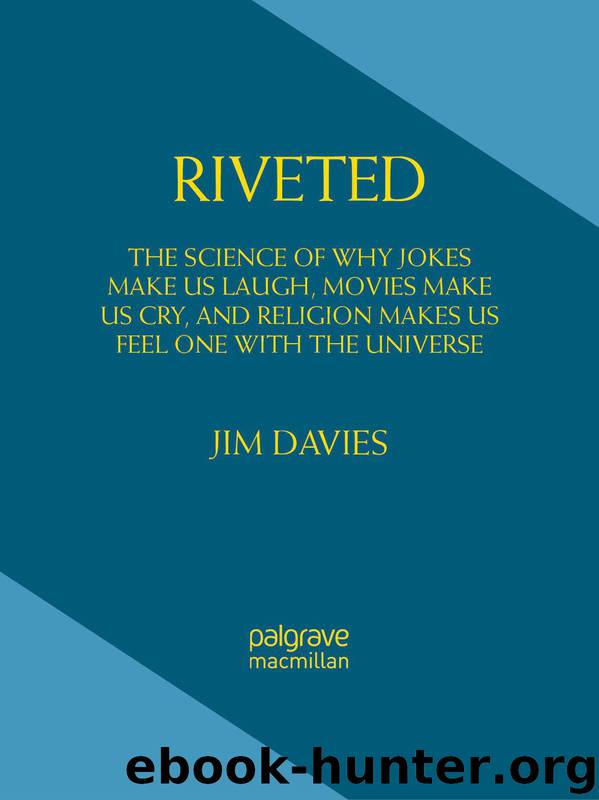Riveted: The Science of Why Jokes Make Us Laugh, Movies Make Us Cry, and Religion Makes Us Feel One with the Universe by Jim Davies

Author:Jim Davies [Davies, Jim]
Language: eng
Format: mobi
Publisher: St. Martin's Press
Published: 2014-08-04T14:00:00+00:00
6
OUR PSYCHOLOGICAL BIASES
We evolved to survive and flourish in the world we happen to live in. But during the course of our lifetimes, we also learn to deal in the world we experience. Be it because of nature, nurture, or some complex relationship between the two, our minds have little tricks they use to help us get by.
Some people are generally critical of these tricks and tend to call them “biases.” Others see them in a more favorable light and tend to call them “heuristics,” which roughly translates as a rule that should usually be followed. Everyone can agree that these tricks work best in environments resembling that of our evolutionary history.1 Problems can occur when these biases, evolved in one environment, are used in other environments, such the one you’re in when choosing a health insurance plan.
Whether biases/heuristics are good or bad, artists and marketers use many of these tricks to win us over. I’ll describe some of these biases and their effects.
* * *
How do you know how likely something is to happen? Or how common something is? Before we had statistics and systematic counting to help us, we used what we saw in our environment as a guide. We still do. Seeing something again and again makes us think it is common and probable. We estimate how often we’ve seen it, in general, by how easily it is brought to memory or, in the language of cognitive psychology, how “available” it is. This is the essence of the availability heuristic. We base our ideas of how probable or common something is on how easily it is brought to memory. This tends to work pretty well when we are only using our sensory perception as input, that is, reasoning about what we directly experience. The trouble starts with communication—when we reason about what we are told, read, and see on video.
We can recall not only things we’ve actually seen, but also reports of what other people have seen—or their reports of other reports. As described in previous chapters, we have good evolutionary reasons to believe the stories that people tell us. Today, we have global communication and we can hear about things happening all over the world. Not only do we read about what’s happening, but we also see what’s happening with television and Internet news. Where we might have evolved some built-in filters for lie detection, video recording has been around for such a short time we can’t possibly have evolved an innate lie filter for it. The result is that we, or most of our minds anyway, believe what we see and even think it’s happening right before our eyes—even if it’s just an Internet video. The effect of the availability heuristic combined with mass media communication is profound: we get a skewed vision of what the world is like from the news.
For example, women in their forties vastly overestimate their chances of getting breast cancer, and this overestimation correlates with news reports about breast cancer.2 This is consistent with the availability heuristic.
Download
This site does not store any files on its server. We only index and link to content provided by other sites. Please contact the content providers to delete copyright contents if any and email us, we'll remove relevant links or contents immediately.
| Administration & Medicine Economics | Allied Health Professions |
| Basic Sciences | Dentistry |
| History | Medical Informatics |
| Medicine | Nursing |
| Pharmacology | Psychology |
| Research | Veterinary Medicine |
The Art of Thinking Clearly by Rolf Dobelli(10329)
The 5 Love Languages: The Secret to Love That Lasts by Gary Chapman(9708)
Mindhunter: Inside the FBI's Elite Serial Crime Unit by John E. Douglas & Mark Olshaker(9266)
Becoming Supernatural by Dr. Joe Dispenza(8171)
Nudge - Improving Decisions about Health, Wealth, and Happiness by Thaler Sunstein(7660)
The Road Less Traveled by M. Scott Peck(7559)
Mastermind: How to Think Like Sherlock Holmes by Maria Konnikova(7281)
Enlightenment Now: The Case for Reason, Science, Humanism, and Progress by Steven Pinker(7274)
Win Bigly by Scott Adams(7142)
The Way of Zen by Alan W. Watts(6557)
Factfulness: Ten Reasons We're Wrong About the World – and Why Things Are Better Than You Think by Hans Rosling(4715)
The State of Affairs by Esther Perel(4692)
Gerald's Game by Stephen King(4612)
Man's Search for Meaning by Viktor Frankl(4507)
The Confidence Code by Katty Kay(4222)
Thinking in Bets by Annie Duke(4186)
The Healing Self by Deepak Chopra(3530)
Hidden Persuasion: 33 psychological influence techniques in advertising by Marc Andrews & Matthijs van Leeuwen & Rick van Baaren(3522)
The Worm at the Core by Sheldon Solomon(3456)
